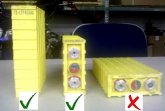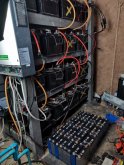Thank you all for replying.
Yes, I understand that weight might be a problem, if stacked too high.
For heat dissipation, I don't see how that can be an issue.
A cell in the middle of a 48v or 96v bank have only its top and bottom to release heat (if any)
For that it doesn't matter placed direction.
In fact, on its side the top and bottom are "free" and can do more heat dissipation.
Fibrations??
God! I hope not for solar storage system!! Earthquake could make the connections go lose, but more likely crash the house on top of it

Liquid?
I don't see how that can be a problem.
The separator "paper" (by lack of knowing better English word for it)
Is "soaked", after this, the liquid does not move.
Battleborn doesn't make it a problem
Other website show the lifepo4 have plates, like lead acid and low liquid level.
I guess I need to find a YouTube to find a video on cut in half lifepo4

Yes, there is
This amazing video!
After some googling..
Our Lifepo4 have the same type of pouches inside.
Together they make the capacity.
It is not one big pouch, but more then one.
Nissan leave appear to have cells on its side, but I don't know if those are lifepo4.
It makes sense to have the cells up straight, or on the short side.
Long side should also not be a problem.
The cells are vacuum.
In a vacuum without air bubbles, the liquid stay in the same location, especially if it can not deform!
For "upsidedown"..
I read that this could prevent the safety vent from opening.
Sadly I was not able to find a person who made video of "our" type of cells.
Reason for asking is clear, I like to put them on their side for space issues.
I still have the 16* 200Ah in my battery room, and planning to keep them there for atleast 3 months.
I'm building 16 de-
sulfator, (based on the 555 timer)
For the 200ah it will take 6 to 10 weeks for de-
sulphation.
Sadly I'm not even sure if that is the real problem.. as it wasn't age or lack of water but too high voltage that killed them.
Anyways, it won't hurt either.
And after 3 months they are as fully charged as possible.
After this, do tests and maybe I can use them as additional backup storage.
Normally it wouldn't have to cycle at all.
Only during the long rainy season the sun might not be enough to fully recharge the lifepo4.
As long as they are there, space is limited.
For first temporary setup they co sideways.
Later I might make raised floor and put them under

(With enough air vents)
That even would make it possible to have the cells 1 mm separated from eachother, provide maximum cooling.
With 0.3C max charging and 0.1 discharge..
There should not be a lot of heat.
Still.... If the place is there to do, then why wouldn't I?






